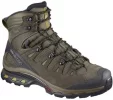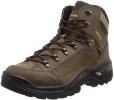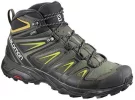Iuri Colares
New Member
- Time of past OR future Camino
- Camino Frances (September 23, 2018)
Which of the following hiking boots would you recommend for Camino Frances from late September through October?
Source: https://www.switchbacktravel.com/best-hiking-boots
1. Salomon Quest 4D 3 GTX

Category: Midweight
Weight: 2 lbs. 13.8 oz.
Waterproof: Yes (Gore-Tex)
What we like: Tough and supportive yet comfortable.
What we don't: Pretty heavy and overkill for most day hiking.
Salomon’s updated Quest 4D 3 GTX is the whole package, combining fantastic comfort, traction, and support for serious day hiking and backpacking. Building on the popular Quest 4D 2, the new boot adds an aggressive outsole that grips well in just about all conditions, and a redesigned, more flexible platform for improved comfort. What stays consistent is the top-notch performance fit, aggressive stance, and durable construction that has made the Quest our favorite all-around hiking boot for years.
The new Quest 4D 3 GTX is not, however, any lighter than the previous model and sits solidly in our midweight category. It was ideal for our trek on the demanding Huemul Circuit in Patagonia, which involved steep climbs and descents and off-trail hiking while carrying a full pack. But the boot is a bit stiff and overkill for people that don’t need the extra protection or want to move fast and light on well-maintained trails. Those folks will be better off with a lighter and nimbler boot option like the Salomon X Ultra 3 Mid GTX below...
2. Lowa Renegade GTX Mid

Category: Midweight
Weight: 2 lbs. 7 oz.
Waterproof: Yes (Gore-Tex)
What we like: Light and comfortable; enough support for most backpackers.
What we don’t: Not the toughest construction.
The Lowa Renegade has the look and feel of a traditional hiking boot at an impressively low weight. Unlike the nimble and more modern Quest above, the leather Renegade offers better isolation from the ground and feels more planted and sturdy. It does give up a little of the fun factor and performance fit of the Quest, but the trade-off is worth it for those carrying a heavy pack or wanting more underfoot protection from rocky trails.
Lowa kept the weight down in part by moving some of the stabilizing duties to a very effective external polyurethane frame. This makes the Renegade perform like a true backpacking boot while weighing less than 2.5 pounds. Further, its leather upper is relatively thin, which saves ounces and reduces break-in time. The sacrifice of all this lightening is a lack of long-term durability—high-mileage users have reported needing a new pair nearly every year. But they keep coming back for the comfortable feel and the right balance of weight and support. And it’s easy to find a good fit as the Renegade is made in narrow, regular, and wide widths...
3. Salomon X Ultra 3 Mid GTX

Category: Lightweight
Weight: 1 lb. 15.6 oz.
Waterproof: Yes (Gore-Tex)
What we like: Fast, light, and flexible.
What we don’t: Thin underfoot and less stable than the Quest 4D.
Built like a trail-running shoe but with added ankle support and protection, the Salomon X Ultra 3 Mid is our favorite ultralight boot. Updated last year, Salomon didn’t mess with the formula: the boots are flexible and feathery light—even 2 ounces lighter per pair than the previous model—but retain decent toe protection, a stable chassis, and a new lug design that grips exceptionally well. For fast-moving day hikers, lightweight backpackers, and thru-hikers, we heartily recommend the X Ultra 3 Mid.
Naturally, there are a few compromises that come with the X Ultra’s lightweight construction. The most significant is the lack of underfoot protection, which is thinner than the Quest 4D above. In addition, the X Ultra also doesn’t sit as high on the ankle as the Quest and isn’t as supportive over technical terrain or when carrying a heavy pack. However, it beats out other ultralight options like the Altra and Adidas below in long-distance comfort, durability, and traction. For those who want to cut even more weight, the X Ultra 3 also is offered in a low-top hiking shoe...
Source: https://www.switchbacktravel.com/best-hiking-boots
1. Salomon Quest 4D 3 GTX

Category: Midweight
Weight: 2 lbs. 13.8 oz.
Waterproof: Yes (Gore-Tex)
What we like: Tough and supportive yet comfortable.
What we don't: Pretty heavy and overkill for most day hiking.
Salomon’s updated Quest 4D 3 GTX is the whole package, combining fantastic comfort, traction, and support for serious day hiking and backpacking. Building on the popular Quest 4D 2, the new boot adds an aggressive outsole that grips well in just about all conditions, and a redesigned, more flexible platform for improved comfort. What stays consistent is the top-notch performance fit, aggressive stance, and durable construction that has made the Quest our favorite all-around hiking boot for years.
The new Quest 4D 3 GTX is not, however, any lighter than the previous model and sits solidly in our midweight category. It was ideal for our trek on the demanding Huemul Circuit in Patagonia, which involved steep climbs and descents and off-trail hiking while carrying a full pack. But the boot is a bit stiff and overkill for people that don’t need the extra protection or want to move fast and light on well-maintained trails. Those folks will be better off with a lighter and nimbler boot option like the Salomon X Ultra 3 Mid GTX below...
2. Lowa Renegade GTX Mid

Category: Midweight
Weight: 2 lbs. 7 oz.
Waterproof: Yes (Gore-Tex)
What we like: Light and comfortable; enough support for most backpackers.
What we don’t: Not the toughest construction.
The Lowa Renegade has the look and feel of a traditional hiking boot at an impressively low weight. Unlike the nimble and more modern Quest above, the leather Renegade offers better isolation from the ground and feels more planted and sturdy. It does give up a little of the fun factor and performance fit of the Quest, but the trade-off is worth it for those carrying a heavy pack or wanting more underfoot protection from rocky trails.
Lowa kept the weight down in part by moving some of the stabilizing duties to a very effective external polyurethane frame. This makes the Renegade perform like a true backpacking boot while weighing less than 2.5 pounds. Further, its leather upper is relatively thin, which saves ounces and reduces break-in time. The sacrifice of all this lightening is a lack of long-term durability—high-mileage users have reported needing a new pair nearly every year. But they keep coming back for the comfortable feel and the right balance of weight and support. And it’s easy to find a good fit as the Renegade is made in narrow, regular, and wide widths...
3. Salomon X Ultra 3 Mid GTX

Category: Lightweight
Weight: 1 lb. 15.6 oz.
Waterproof: Yes (Gore-Tex)
What we like: Fast, light, and flexible.
What we don’t: Thin underfoot and less stable than the Quest 4D.
Built like a trail-running shoe but with added ankle support and protection, the Salomon X Ultra 3 Mid is our favorite ultralight boot. Updated last year, Salomon didn’t mess with the formula: the boots are flexible and feathery light—even 2 ounces lighter per pair than the previous model—but retain decent toe protection, a stable chassis, and a new lug design that grips exceptionally well. For fast-moving day hikers, lightweight backpackers, and thru-hikers, we heartily recommend the X Ultra 3 Mid.
Naturally, there are a few compromises that come with the X Ultra’s lightweight construction. The most significant is the lack of underfoot protection, which is thinner than the Quest 4D above. In addition, the X Ultra also doesn’t sit as high on the ankle as the Quest and isn’t as supportive over technical terrain or when carrying a heavy pack. However, it beats out other ultralight options like the Altra and Adidas below in long-distance comfort, durability, and traction. For those who want to cut even more weight, the X Ultra 3 also is offered in a low-top hiking shoe...



















